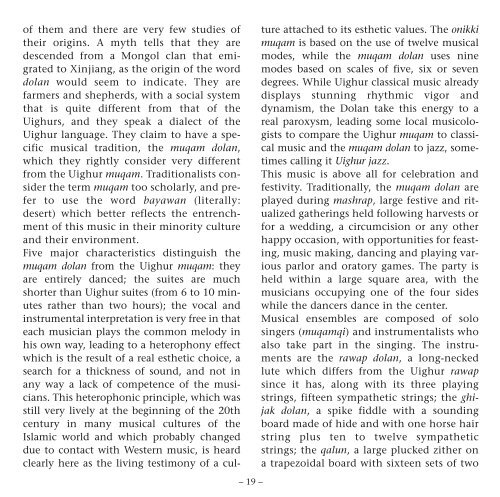Turkestan chinois, LE MUQAM DES DOLAN - Document sans titre ...
Turkestan chinois, LE MUQAM DES DOLAN - Document sans titre ...
Turkestan chinois, LE MUQAM DES DOLAN - Document sans titre ...
Create successful ePaper yourself
Turn your PDF publications into a flip-book with our unique Google optimized e-Paper software.
of them and there are very few studies of<br />
their origins. A myth tells that they are<br />
descended from a Mongol clan that emigrated<br />
to Xinjiang, as the origin of the word<br />
dolan would seem to indicate. They are<br />
farmers and shepherds, with a social system<br />
that is quite different from that of the<br />
Uighurs, and they speak a dialect of the<br />
Uighur language. They claim to have a specific<br />
musical tradition, the muqam dolan,<br />
which they rightly consider very different<br />
from the Uighur muqam. Traditionalists consider<br />
the term muqam too scholarly, and prefer<br />
to use the word bayawan (literally:<br />
desert) which better reflects the entrenchment<br />
of this music in their minority culture<br />
and their environment.<br />
Five major characteristics distinguish the<br />
muqam dolan from the Uighur muqam: they<br />
are entirely danced; the suites are much<br />
shorter than Uighur suites (from 6 to 10 minutes<br />
rather than two hours); the vocal and<br />
instrumental interpretation is very free in that<br />
each musician plays the common melody in<br />
his own way, leading to a heterophony effect<br />
which is the result of a real esthetic choice, a<br />
search for a thickness of sound, and not in<br />
any way a lack of competence of the musicians.<br />
This heterophonic principle, which was<br />
still very lively at the beginning of the 20th<br />
century in many musical cultures of the<br />
Islamic world and which probably changed<br />
due to contact with Western music, is heard<br />
clearly here as the living testimony of a cul-<br />
– 19 –<br />
ture attached to its esthetic values. The onikki<br />
muqam is based on the use of twelve musical<br />
modes, while the muqam dolan uses nine<br />
modes based on scales of five, six or seven<br />
degrees. While Uighur classical music already<br />
displays stunning rhythmic vigor and<br />
dynamism, the Dolan take this energy to a<br />
real paroxysm, leading some local musicologists<br />
to compare the Uighur muqam to classical<br />
music and the muqam dolan to jazz, sometimes<br />
calling it Uighur jazz.<br />
This music is above all for celebration and<br />
festivity. Traditionally, the muqam dolan are<br />
played during mashrap, large festive and ritualized<br />
gatherings held following harvests or<br />
for a wedding, a circumcision or any other<br />
happy occasion, with opportunities for feasting,<br />
music making, dancing and playing various<br />
parlor and oratory games. The party is<br />
held within a large square area, with the<br />
musicians occupying one of the four sides<br />
while the dancers dance in the center.<br />
Musical ensembles are composed of solo<br />
singers (muqamqi) and instrumentalists who<br />
also take part in the singing. The instruments<br />
are the rawap dolan, a long-necked<br />
lute which differs from the Uighur rawap<br />
since it has, along with its three playing<br />
strings, fifteen sympathetic strings; the ghijak<br />
dolan, a spike fiddle with a sounding<br />
board made of hide and with one horse hair<br />
string plus ten to twelve sympathetic<br />
strings; the qalun, a large plucked zither on<br />
a trapezoidal board with sixteen sets of two



